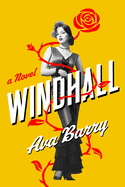
The narrator of the thoroughly cinematic novel Windhall, Max Hailey, is a journalist with the Los Angeles Lens. He would gladly swap modern-day L.A.'s artisanal coffee-drinking hipsters for the impeccably dressed sidecar-swilling swells of the 1940s, and has long been captivated by the unsolved 1948 murder of movie star Eleanor Hayes. As the story goes, one night at a party at Windhall, the Benedict Canyon mansion belonging to A-list director Theodore Langley, he fatally stabbed the actress in his garden. Theo was arrested, but evidence tampering foiled the case against him. After he was released from all charges, he seemed to vanish. Windhall has been unoccupied ever since.
Sixty-nine years later, the body of a young woman is found in a garden near Windhall; she's wearing a green silk dress like the one that Eleanor was killed in and, like Eleanor, she has been stabbed. Spurred by the media's flogging of the two deaths' parallels, Max decides to write a story about Theo and prove that the director killed Eleanor. Still, even Max has to wonder how logical it would have been for a director to murder his star when they were in the middle of shooting a movie.
Windhall is such an intoxicating throwback that readers may find themselves picturing Max in a fedora and trench coat as he noses around a faded Los Angeles, following up leads. Ava Barry's sparkling debut has Sunset Boulevard's curdled-glamor mise-en-scène, All About Eve's backstage intrigue and The Day of the Locust's crushing disillusionment with Tinseltown. --Nell Beram, author and freelance writer

